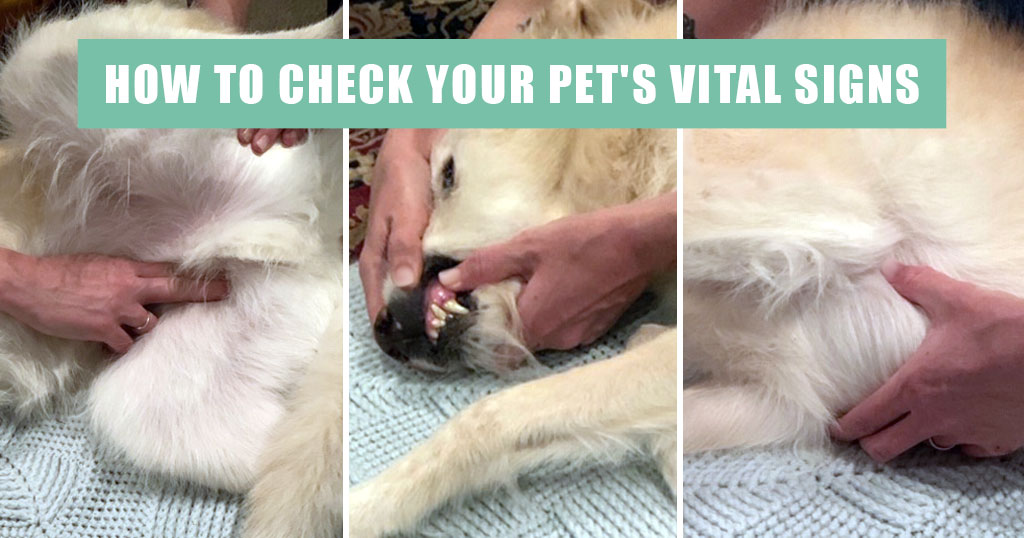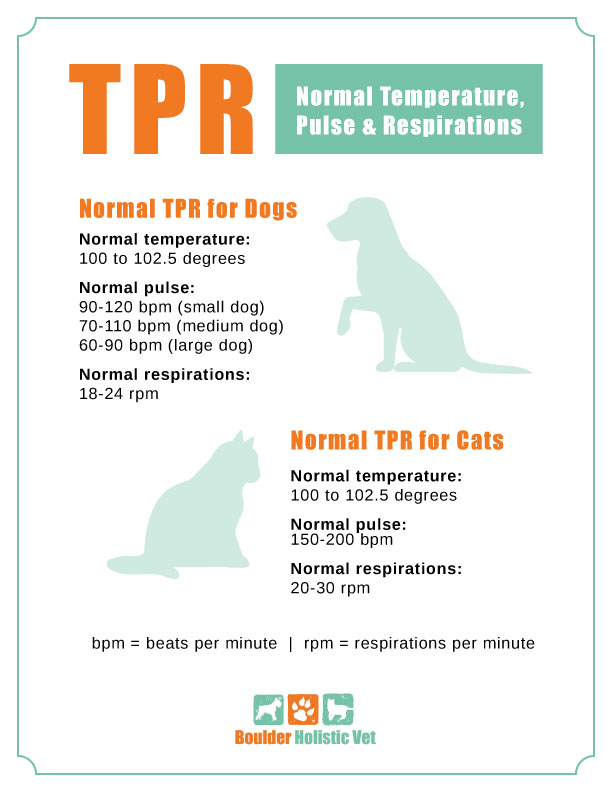Understanding the basics of how to assess pet vital signs at home is an important skill for every pet parent. Vital signs are measurements of your pet’s most important body functions (like temperature, for example). Knowing what’s normal and what’s not will allow you to respond fast while providing your veterinary team with the information they need in the event of an emergency.
In this blog, I will go over how to collect pet vital signs at home, signs that your pet may be in distress, and what to do in an emergency.
What’s a TPR?
TPR stands for temperature, pulse and respirations. These are the first pet vital signs collected at the time of your dog or cat’s veterinary visit. I would recommend checking your pet’s TPR periodically when you are resting together, so that you can have an adequate understanding of what is “normal” for them.
Below is a chart outlining the normal TPR for both dogs and cats. Click this chart for a printable PDF version to place on your fridge, with your pet supplies or in your pet’s first aid kit!
How to collect a TPR on your pet.
Temperature:
The quickest way to collect a temperature on your dog or cat is by using a digital thermometer rectally. Unfortunately, we have yet to create a thermometer for pets that can roll across the forehead (although when this is invented, I better see it on Shark Tank!).
You will need:
- A digital thermometer (keep this in your pet’s first aid kit and away from the family thermometer!)
- Generic lubricant (like petroleum jelly).
- Alcohol wipes
Place a small amount of lubricant on the tip of your pet’s thermometer. Gently insert the thermometer into your pet’s rectum, inserting no more than 1”. You can do this with your pet standing or laying down. Sometimes feeding treats or frozen baby food can help this experience be less stressful for your pet. Clean the thermometer using alcohol wipes between each use or, alternatively, you can use disposable thermometer covers.
When taking your pet’s temperature, it’s important to consider their surroundings. Is it cold or hot where they are? Were they just running, or are they stressed? Considerations like this will contribute to their current core body temp.
Pulse/heart rate:
You will need:
- A stopwatch (most smartphones have this feature) or you can find one online here.
You can often get your pet’s heart rate by placing your hand directly over their heart. The heart is located on the left side of your pet’s chest. If you are having trouble finding the location, you can bring your pet’s elbow to their chest. The point at which your pet’s elbow meets the chest is the location of the heart. Once you have found the heartbeat, you will count how many beats per minute you are hearing. You can do this by counting how many beats you hear in 15 seconds and then multiply that number by 4. For example, if you hear 20 beats in 15 seconds, you will multiply 20 by 4 to get 80 bpm.
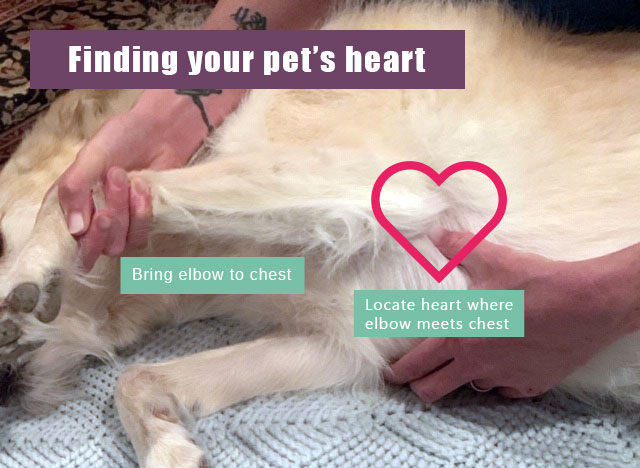
Alternatively, you can also obtain a pulse by placing two fingers together and gently placing on top of a major artery. For pets, the easiest location is the femoral artery, which can be found on the inner, middle and upper part of the back leg/thigh.
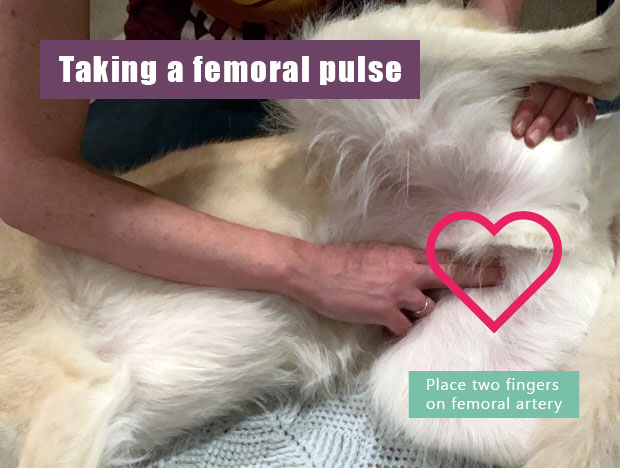
It is ideal to collect your pet’s heart rate when they are resting or sleeping, as opposed to after playing or while stressed. This will give you the most accurate reading and avoid falsely elevated numbers. Resting heart rates will be faster in smaller dogs or cats than in medium or large sized dogs.
Respirations:
You will need:
- A stopwatch
A complete respiration includes one inhale and one exhale. Watching your pet while they are sleeping or resting is best, to avoid a falsely elevated respiration count. To collect your pet’s respirations, count how many inhales and exhales you see from your pet in 15 seconds and multiply that number by 4. This will give your pet’s rpm (respirations per minute). Remember, one inhale and one exhale count as a single respiration! Smaller dogs and cats have faster rpms than medium or large sized dogs. A Great Dane will naturally breathe much slower than a 4 pound chihuahua or kitten!
Gum color
When your veterinarian checks your cat or dog’s gum color, they are assessing your pet’s capillary refill time (CRT). Capillary refill time is defined as the amount of time that it takes blood to return to an external capillary bed after applying pressure. For our dogs, this information is most commonly obtained by pressing against their gums and counting how long it takes for them to return back to a healthy pink color. A normal CRT for cats and dogs is less than 2 seconds. A prolonged CRT indicates blood is not flowing adequately. This test can be challenging if your dog has black gums, and so another area like the inside of your pup’s ear can be an excellent alternative. White or blue gums is a sign your pet is having difficulty oxygenating and is in distress.
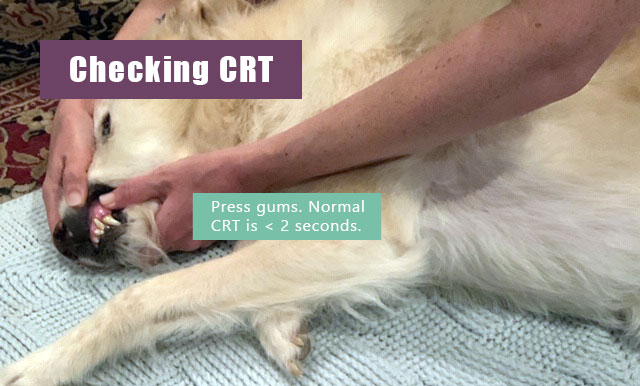
Hydration
One of the easiest ways to check your pet’s hydration status is simply by monitoring their intake of fluids and how often they are urinating. A cat or dog that is experiencing vomiting and diarrhea, or not eating and drinking, is at risk of becoming dehydrated quickly. Certain diseases, like kidney disease, can also cause dehydration. Depending on your pet’s levels of dehydration, your veterinarian will likely administer either subcutaneous or intravenous fluids. Ensuring your pet has constant access to water and high moisture foods (like canned or raw foods) can help with maintaining hydration in healthy pets.
Here are a few signs that your pet is in possible distress and should be seen by a veterinarian:
- Your pet’s TPR is abnormal.
- Your dog or cat is having difficulty breathing.
- Your cat is open mouth breathing or coughing.
- Your pet’s gum color is blue or white.
- Your pet is unable to walk or stand.
- Your pet is unable to hold down food or water, or your cat has not eaten in 72 hours.
It’s important to always be working with your veterinary team while assessing your dog or cat’s vitals during an emergency! Taking a local or online pet CPR course is a great way to stay educated and prepared. Make sure your cat or dog’s regular veterinarian, local emergency clinic and Pet Poison Helpline contact information is readily available (go ahead and save these contacts in your phone, or add their info onto your fridge!).
What to do in an emergency situation.
If you and your pet are in the midst of an emergency, the best thing you can do is stay as calm as possible. I know this can be so hard. Contact your veterinarian immediately, and allow for them to walk you through next steps. Veterinarians and their team are trained for all situations and are there to help you! Calling them in advance and letting them know you are in route to the hospital will also allow for them to be as prepared as possible upon your arrival.
Knowledge is power! Taking the time to practice checking pet vital signs is actually an act of love! Knowing what is normal for your cat or dog allows you to understand or identify if something is off. You are a rockstar pet parent, and your pet is lucky to have you!
Big hugs,
Claire

